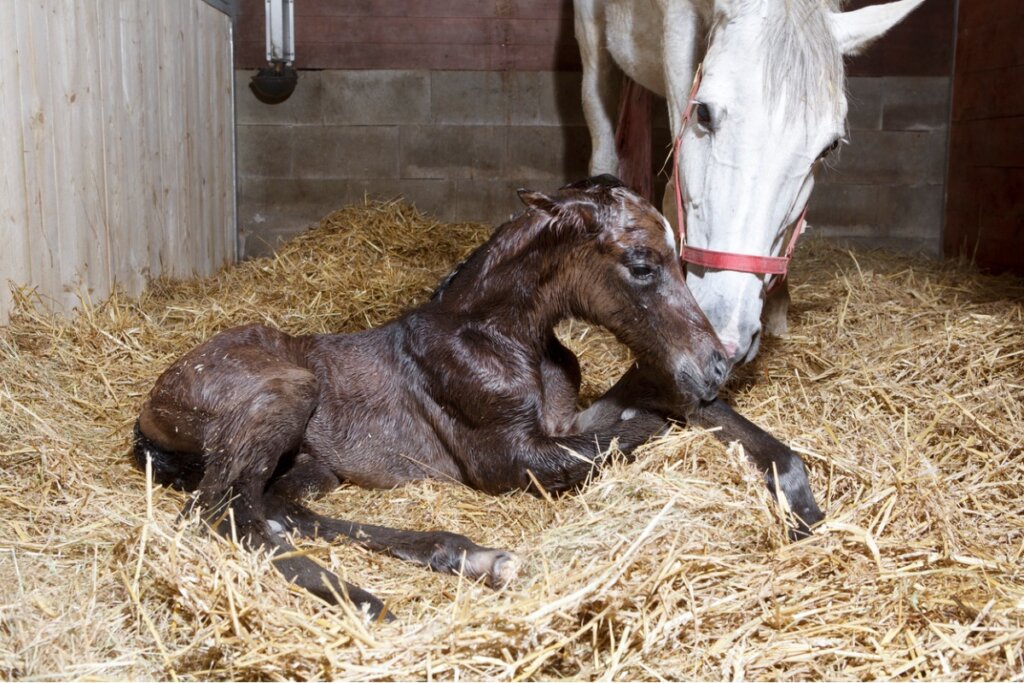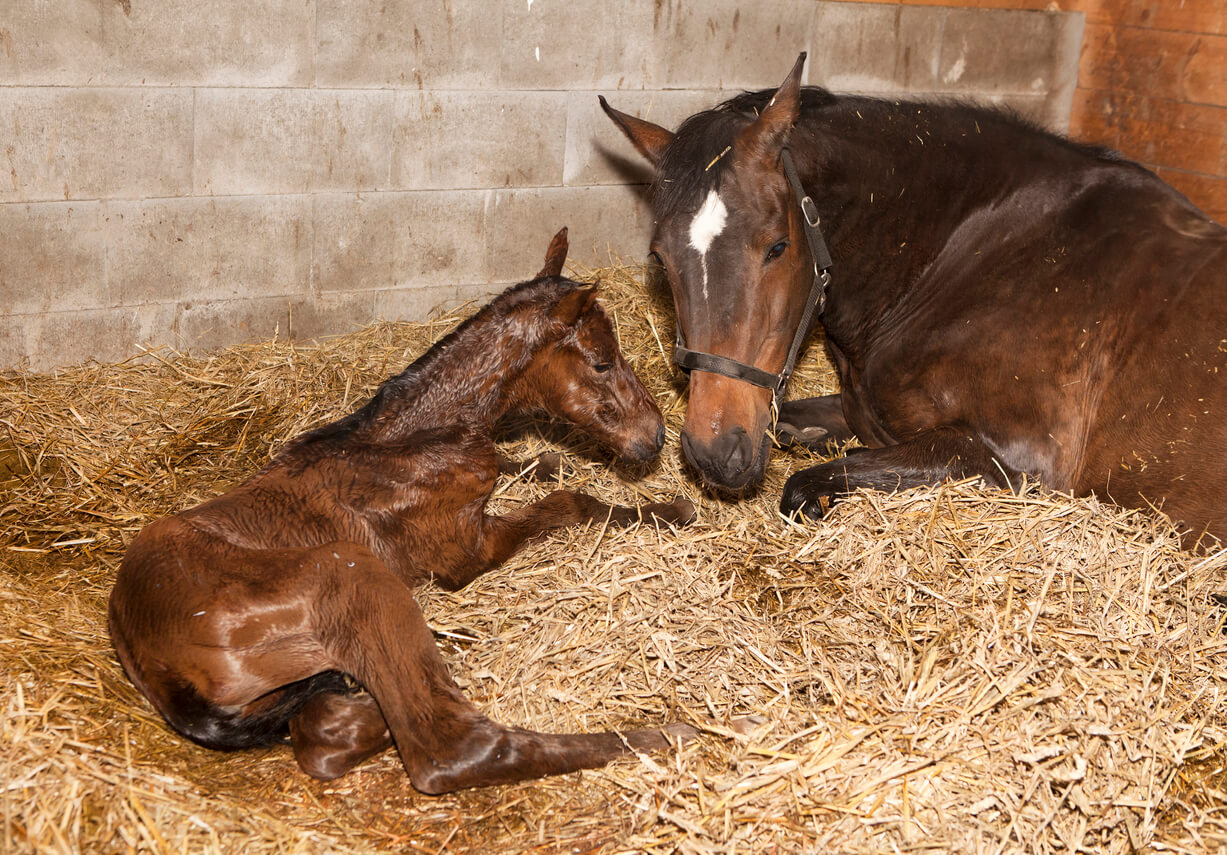Equine Neonatal Sepsis - Symptoms and Treatment

Foaling is a complicated time for mothers and foals alike. The complications that can arise are many, but in this case, we’re going to talk about equine neonatal sepsis, which is often fatal for the foal soon after birth.
Receiving the mother’s defenses through colostrum is key to ensuring that the foal doesn’t become ill once it enters the world. However, many factors can cause this disease. If you want to know more about equine neonatal sepsis, here’s all the information you need.
What’s equine neonatal sepsis?
Equine neonatal sepsis is a disease caused by the presence of bacteria in the blood of the newborn foal. As these bacteria move through the circulatory system, they spread throughout the body and cause damage to the lungs, joints, kidneys, digestive system, and nervous system.
Neonatal sepsis is a major cause of mortality and morbidity in equines in the first 7 days of life.
The most common bacterium identified in septic foals is Escherichia coli. Other pathogens commonly found in the blood of the infected animal are species of the genera Klebsiella, Enterobacter, Actinobacillus, Salmonella, Pseudomonas, and Streptococcus.
Some of these bacteria contain a toxin in their cell walls called endotoxin. This endotoxin stimulates the release of cytokines in the body, causing the typical symptoms of fever, anorexia, and lethargy in the infected animal.

Causes of disease
The main risk factor for equine neonatal sepsis is when the foal doesn’t take in an adequate amount of good quality maternal colostrum. This first milk produced by the mother contains a high level of antibodies, which will protect the foal from pathogens in the first few days of life.
However, this isn’t the only reason why a foal may develop a serious infection that leads to sepsis. Here are other predisposing factors:
- Poor environmental hygiene: If the facilities of the mare and her foal aren’t properly cleaned, bacteria will proliferate
- Premature birth of the foal
- Poor health of the mother
- A difficult birth
- Presence of germs in the environment against which the mother has no defenses (so she isn’t able to pass them on to the foal through the colostrum)
The symptoms usually appear about 12 hours after the birth of the foal and are very evident. In the following sections, you’ll find out about them in detail.
Symptoms of equine neonatal sepsis
The most visible sign is the extreme weakness of the foal, as it has no strength to stand up and has difficulty in standing still. Other typical symptoms of this condition are as follows:
- Pale mucous membranes
- Fever
- Muscle tremors
- Respiratory difficulties
- Intense diarrhea with consequent dehydration.
- Symptoms specific to the organs affected by the bacteria
- Death can occur after a few hours
The disease has another variant, which is acute but slower to develop, and which has a higher probability of survival in the foal. Symptoms appear later (24-48 hours) and are as follows:
- Congestive mucous membranes
- Fever
- Difficulty in sitting up
- Joint pain in the extremities
- Diarrhea with subsequent dehydration.
- If the foal survives, it will be left with severe septic arthritis that will prevent it from moving normally.
Diagnosis of equine neonatal sepsis
It’s often difficult to diagnose this disease early, as the signs are variable and common to other diseases. However, a blood culture can be performed to identify the bacteria present.
A blood test can be used to assess the amount of immunoglobulin G. If these defenses are low, it’s a sign that the foal hasn’t received sufficient colostrum. Other representative values seen in the biochemistry are low erythrocytes and hemoglobin, low blood sugar, and high urea.
If a sample of synovial fluid is taken, it will show a purulent fluid that contains a large amount of neutrophils due to infection. After confirming sepsis, a complete physical examination of the animal is necessary.
Treatment of equine neonatal sepsis
General treatment is with high-dose, high-spectrum antibiotics, given the urgency and extent of the infection. Plasma transfusions are also recommended to provide the foal with intravenous antibodies.
As the foal is dehydrated and has low blood sugar levels, glucose saline will be given intravenously or orally to help it recover. Since the foal may not be able to feed itself at this time, he should be given mare’s milk in small amounts, but very often.
A nasogastric tube may be necessary if the foal won’t suck on a bottle. If this is the case, a syringe should never be used, as this can cause choking.
If there’s infectious arthritis, it’ll be necessary to wash the joints with sterile fluids. When respiratory symptoms are present, artificial ventilation or oxygen should also be provided. The foal’s environment should be kept as aseptic as possible. In addition, the floor should be padded to prevent bedsores, as the animal will spend most of its time lying down.

The prognosis for this disease varies from stable to severe.
Recovery depends on the severity of the infection and the organs affected. If the foal is admitted to a veterinary hospital, the chances of survival increase, but aren’t usually more than 75%. If treatment is effective and subsequent intensive care is carried out rigorously, the foal can grow to become a healthy adult.
All cited sources were thoroughly reviewed by our team to ensure their quality, reliability, currency, and validity. The bibliography of this article was considered reliable and of academic or scientific accuracy.
- Ospina Chirivi, J. C., & Ronderos Herrera, M. D. (2014). Fisiopatología de la septicemia neonatal equina. Revista de Medicina Veterinaria, 1(28), 117-125.
- Bedenice, D. (2021, 26 octubre). Septicemia in Foals. MSD Veterinary Manual. Recuperado 3 de noviembre de 2021, de https://www.msdvetmanual.com/horse-owners/disorders-affecting-multiple-body-systems-of-horses/septicemia-in-foals
- Moreno Camelo, N. A. (2021). Septicemia neonatal equina en potro clonado concebido a partir de un embrión vitrificado de raza polo argentino.
- Franco Ayala, M. S., & Oliver Espinosa, O. J. (2015). Enfermedades de los potros neonatos y su epidemiología: una revisión. Revista de Medicina Veterinaria, (29), 91-105.
